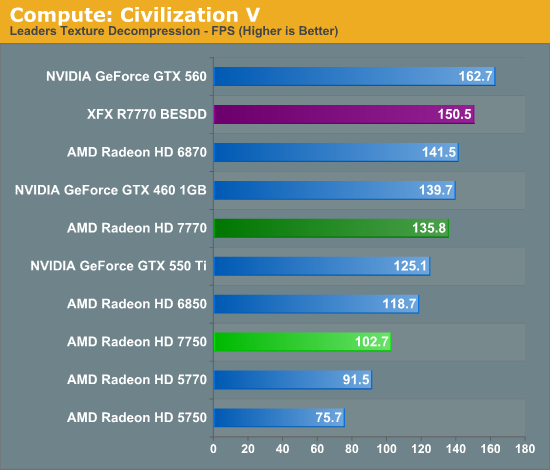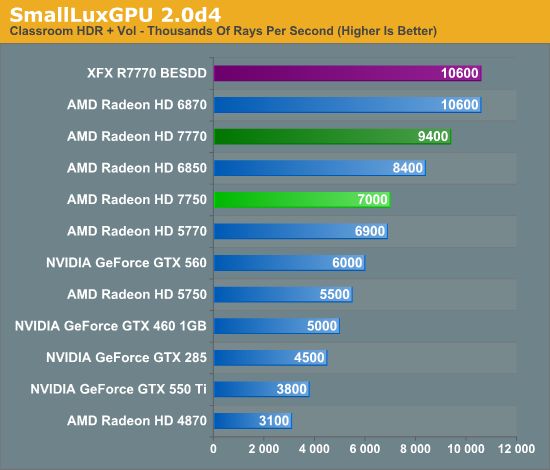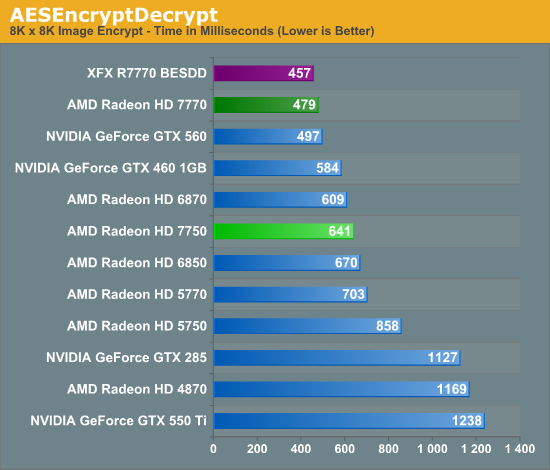AMD Radeon HD 7750 & Radeon HD 7770 GHz Edition Review: Evading The Price/Performance Curve
by Ryan Smith & Ganesh T S on February 15, 2012 12:01 AM EST- Posted in
- GPUs
- AMD
- HTPC
- GCN
- Radeon HD 7000
Compute Performance
Moving on from our look at gaming performance, we have our customary look at compute performance. With GCN AMD significantly overhauled their architecture in order to improve compute performance, as their long-run initiatives rely on GPU compute performance becoming far more important than it is today.
With such a move however AMD has to solve the chicken and the egg problem on their own, in this case by improving compute performance before there are really a large variety of applications ready to take advantage of it. As we’ll see AMD has certainly achieved that goal, but it raises the question of what was the tradeoff for that? We have some evidence that GCN is more efficient than VLIW5 on a per-shader basis even in games, but at the same time we can’t forget that AMD has gone from 800 SPs to 640 SPs in the move from Juniper to Cape Verde, in spite of a full node jump in fabrication technology. In the long run AMD will be better off, but I suspect we’re looking at that tradeoff today with the 7700 series.
Our first compute benchmark comes from Civilization V, which uses DirectCompute to decompress textures on the fly. Civ V includes a sub-benchmark that exclusively tests the speed of their texture decompression algorithm by repeatedly decompressing the textures required for one of the game’s leader scenes. Note that this is a DX11 DirectCompute benchmark.

Theoretically the 5770 has a 5% compute performance advantage over the 7770. In practice the 5770 doesn’t stand a chance. Even the much, much slower 7750 is ahead by 12%, meanwhile the 7770 is in a class of its own, competing with the likes of the 6870. The 7770 series still trails the GTX 560 to some degree, but once again we’re looking at the proof of just how much the GCN architecture has improved AMD’s compute performance.
Our next benchmark is SmallLuxGPU, the GPU ray tracing branch of the open source LuxRender renderer. We’re now using a development build from the version 2.0 branch, and we’ve moved on to a more complex scene that hopefully will provide a greater challenge to our GPUs.

SmallLuxGPU is another good showing for the GCN based 7700 series, with the 7770 once again moving well up the charts. This time it’s between the 6850 and 6870, and well, well ahead of the GTX 560 or any other NVIDIA video cards. Throwing in an overclock pushes things even farther, leading to the XFX BESDD tying the 6870 in this benchmark.
For our next benchmark we’re looking at AESEncryptDecrypt, an OpenCL AES encryption routine that AES encrypts/decrypts an 8K x 8K pixel square image file. The results of this benchmark are the average time to encrypt the image over a number of iterations of the AES cypher.

Under our AESEncryptDecrypt benchmark the 7770 does even better yet, this time taking the #2 spot and only losing to its overclocked self. PCIe 3.0 helps here, but as we’ve seen with the 7900 series there’s no replacement for a good compute architecture.
Finally, our last benchmark is once again looking at compute shader performance, this time through the Fluid simulation sample in the DirectX SDK. This program simulates the motion and interactions of a 16k particle fluid using a compute shader, with a choice of several different algorithms. In this case we’re using an (O)n^2 nearest neighbor method that is optimized by using shared memory to cache data.

It would appear we’ve saved the best for last, as in our fluid simulation benchmark the top three cards are all 7700 series cards. This benchmark strongly favors a well organized cache, leading to the 7700 series blowing past the 6800 series and never looking back. Even NVIDIA’s Fermi based video cards can’t keep up.










155 Comments
View All Comments
rdh - Wednesday, February 15, 2012 - link
Bingo. But your numbers look at if you were to want to buy today. You might have bought the 5750 or 5770 at a significantly lower cost during a sale in the past 2.5 years. So individual price comparisons may be different than today's prices.IN ADDITION: the 7770 and 7750 require about 3% less power and produce frame rates about 10% higher than their 57xx counterparts. This is after the 57xx have been out for nearly TWO AND HALF YEARS. I purchased both (the 5750 for one system at $65 and the 5770 for another at $99) about 6 months after introduction. Two years later, there is no compelling reason for me to upgrade. That means AMD is only going to be selling these to new desktop purchasers.... a quickly shrinking market. This cannot be good for AMD.
CeriseCogburn - Saturday, March 10, 2012 - link
Since fps is your only metric, itself being a murky and disturbed error filled easily biased mess based upon game set, driver cheating, resolutions, and in game settings chosen, the entire price/perf chart is EPIC FAIL.When your drivers crash, when your game doesn't work, when new games don't work for weeks and months, when dual card drivers are absent, when features like PhysX are no can do - NONE OF IT IS ACCOUNTED FOR....
---
Obviously all amd has to do is follow the simpleton idiot fps/per dollar formula for all the stuck cursor gsod fanboys to bloviate and screech they saved 20 cents... then the amd forum masters casn continue to lock them out, lock user problem threads, and smart off that "it's works for them on their eyefinity setup theya re starig at right now"...
---
When a crazed, worship filled, religious zealoutry claims the heavens have opened on the cheap and the devil competition has lost all, beware...
Oh.. wait... sorry talking to the wrong person...
Roland00Address - Wednesday, February 15, 2012 - link
I am curious how high these cards will go before they hit the powertune limits.Ryan Smith - Wednesday, February 15, 2012 - link
I'm still writing up an addendum, but here's what I have for the 7770.Ref 7770: 1125MHz core, 4.8GHz memory
XFX 7770: No meaningful overclock on top of XFX's factory overclock. Crashed at 1160MHz core
As for performance, basically look at the XFX card.
Roland00Address - Wednesday, February 15, 2012 - link
Personally I find that the more interesting cardRyan Smith - Wednesday, February 15, 2012 - link
We didn't do any overclocking tests on the 7750. It was necessary to quickly test it in order to be able to ship it to Ganesh for HTPC testing.DarkSynergyt - Wednesday, February 15, 2012 - link
Might be a stupid question but can the 7750 output audio over HDMI? I'm in the process of building an HTPC and this is the final piece to the build.evilspoons - Wednesday, February 15, 2012 - link
My 6570 can and I'm pretty sure they said in the review that it has all the same features as previous generations for video features.ganeshts - Wednesday, February 15, 2012 - link
Yes, it does. With full bitstreaming options too (even WMA Pro). 7.1 channel LPCM support is also there. No worries. (Of course, hot plugging [ say, moving from a direct monitor connection to an AV receiver input ] causes the audio output to act crazy, but that is the case with every card. Reboot fixes the issue)evilspoons - Wednesday, February 15, 2012 - link
This really drives home how obsolete my GTX 285 is. The 7770 has about equivalent performance and uses *130 watts* less.I need a new video card, but I want to see what Nvidia has for us next - I'm not a fanboy (in spite of all my gaming cards since the 3dfx Voodoo 3 being Nvidia), I'm just genuinely hoping for either some competition to drive prices down or something better to blow us away. Come on guys, get a move on already!